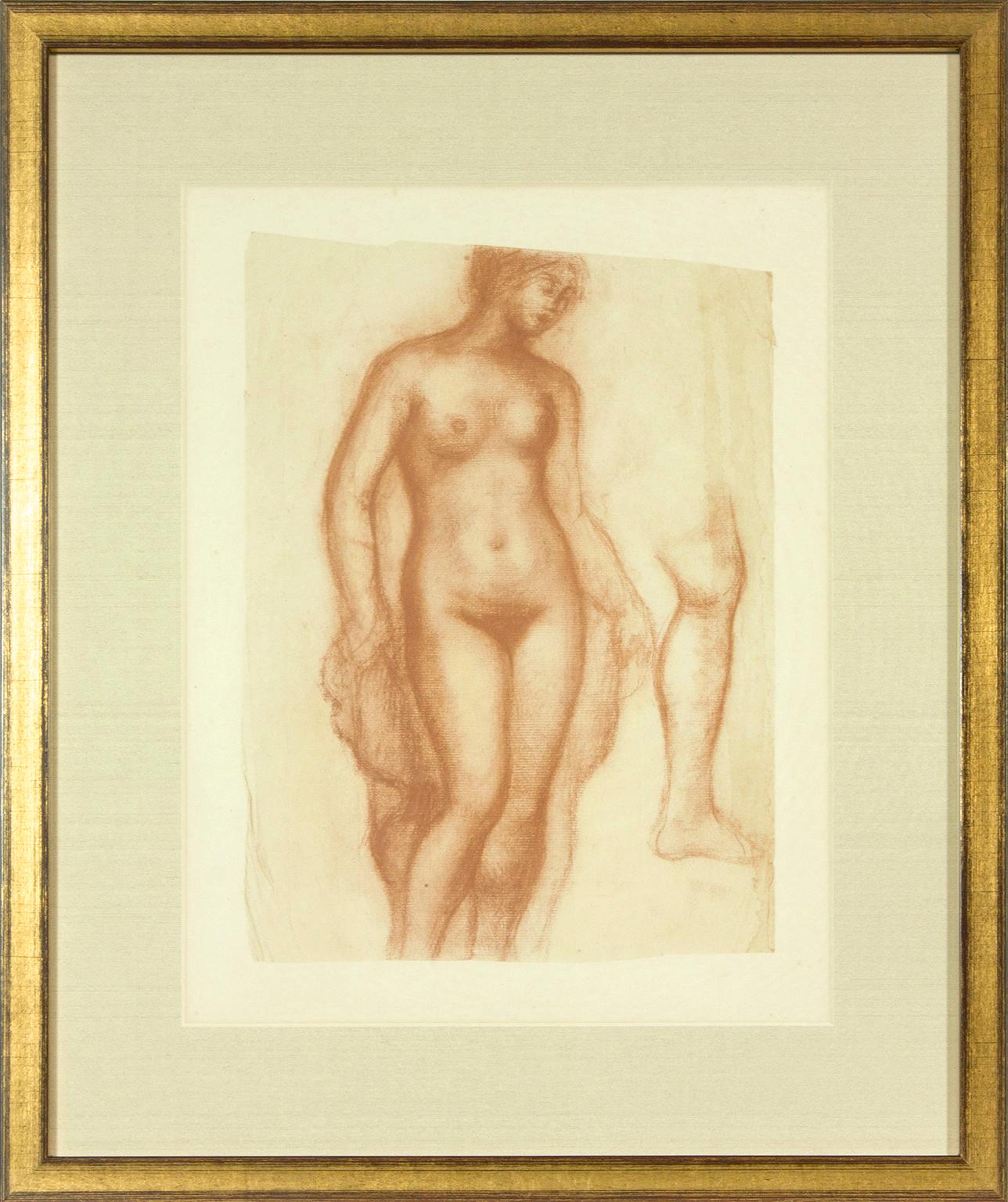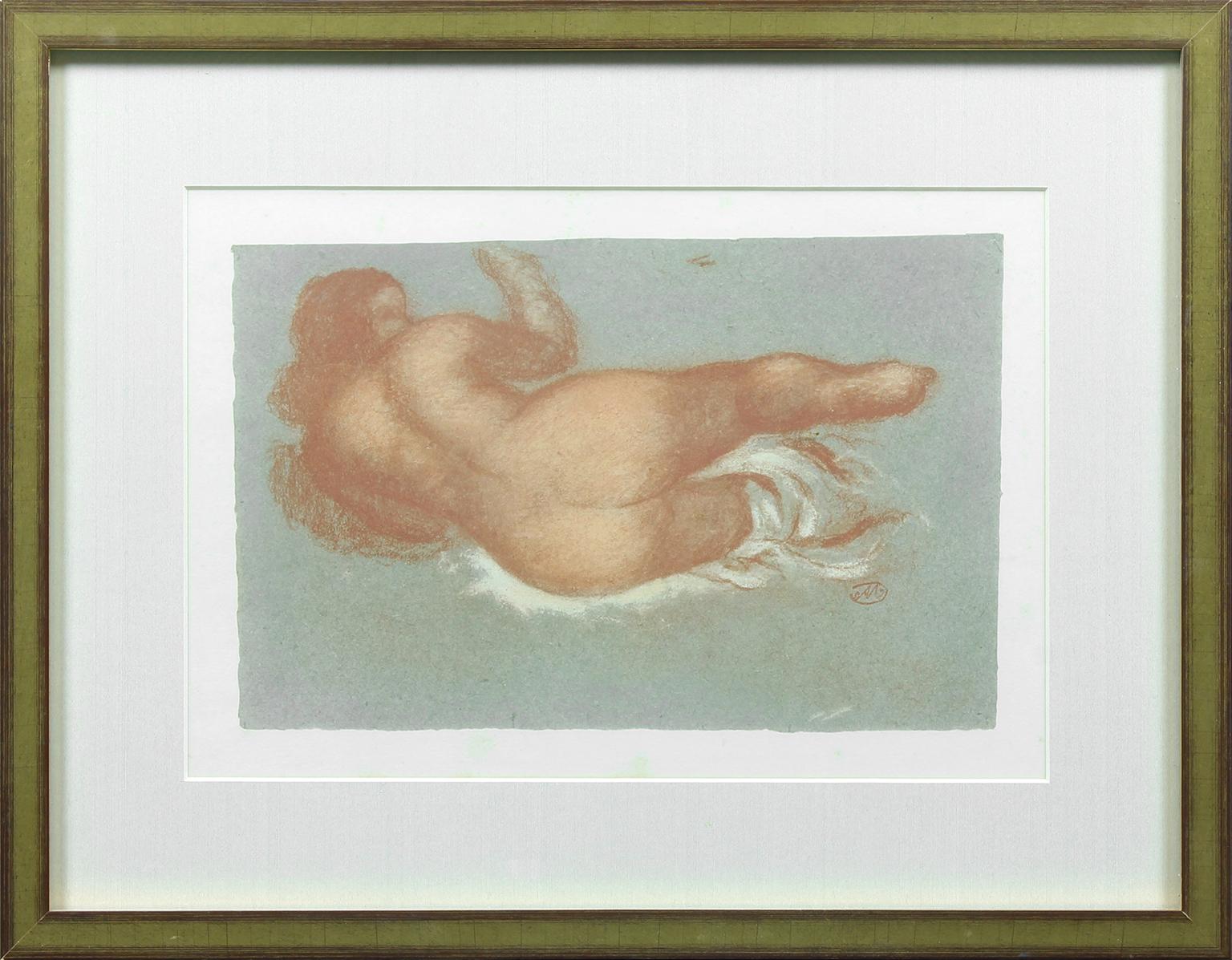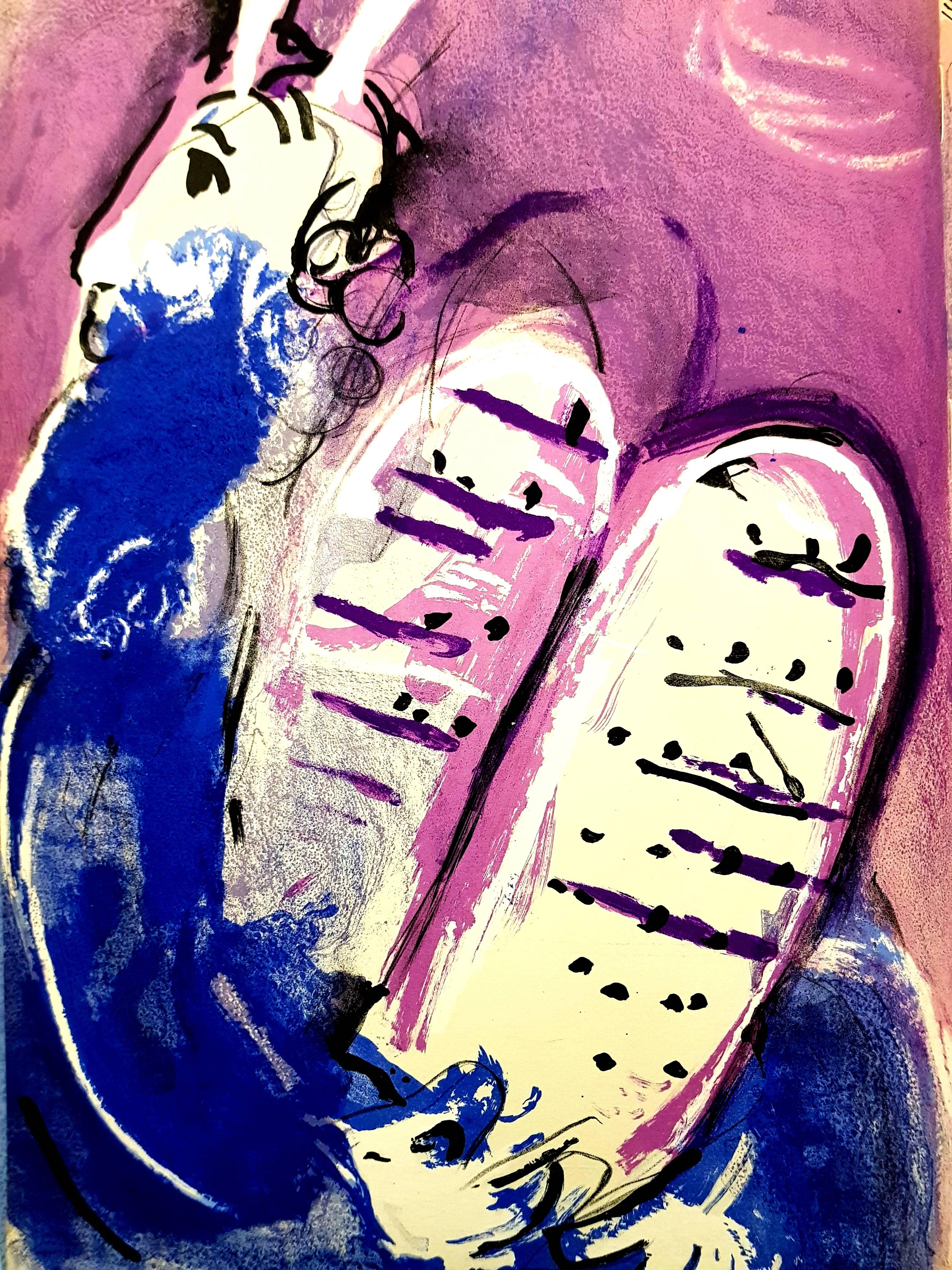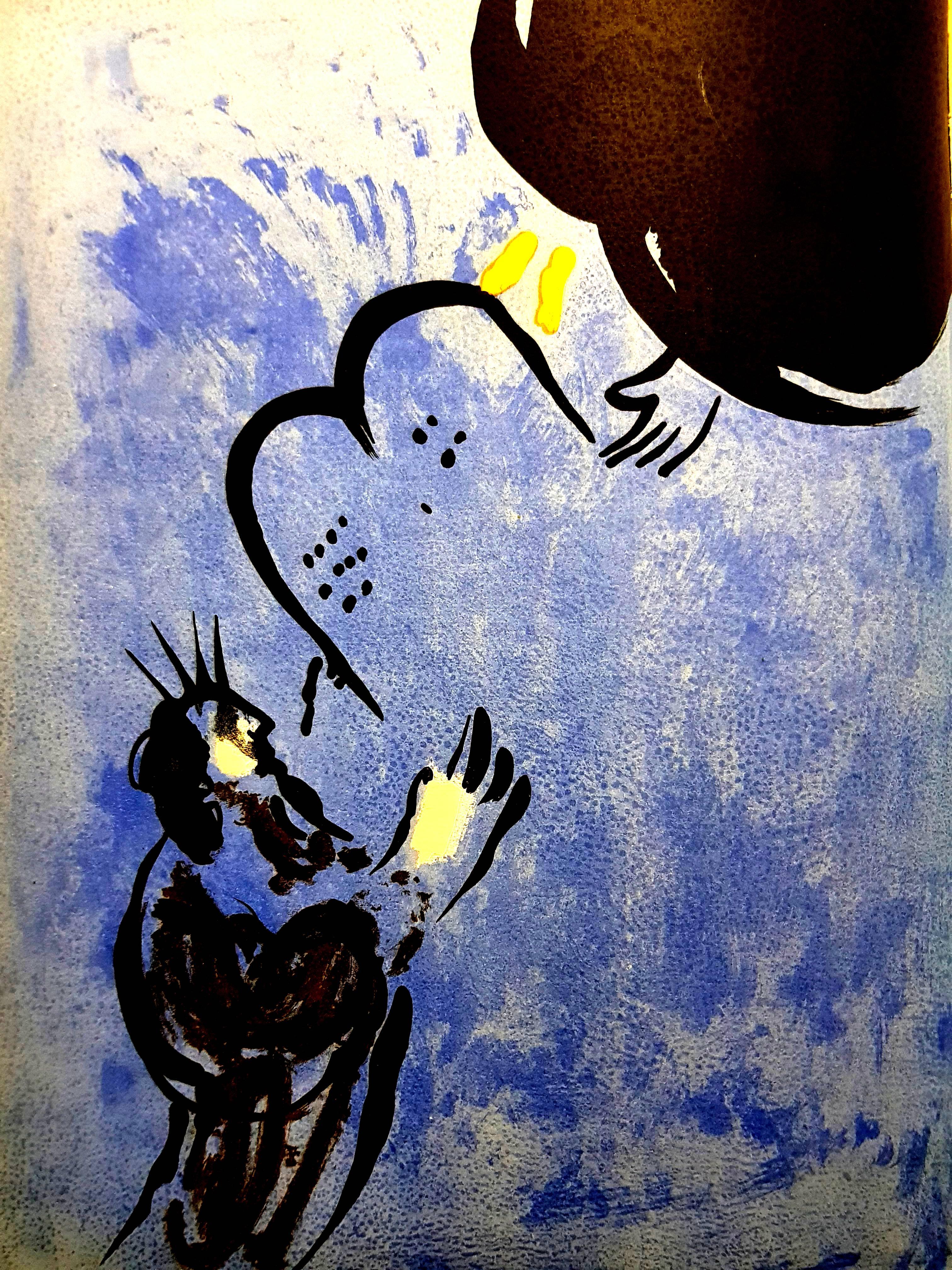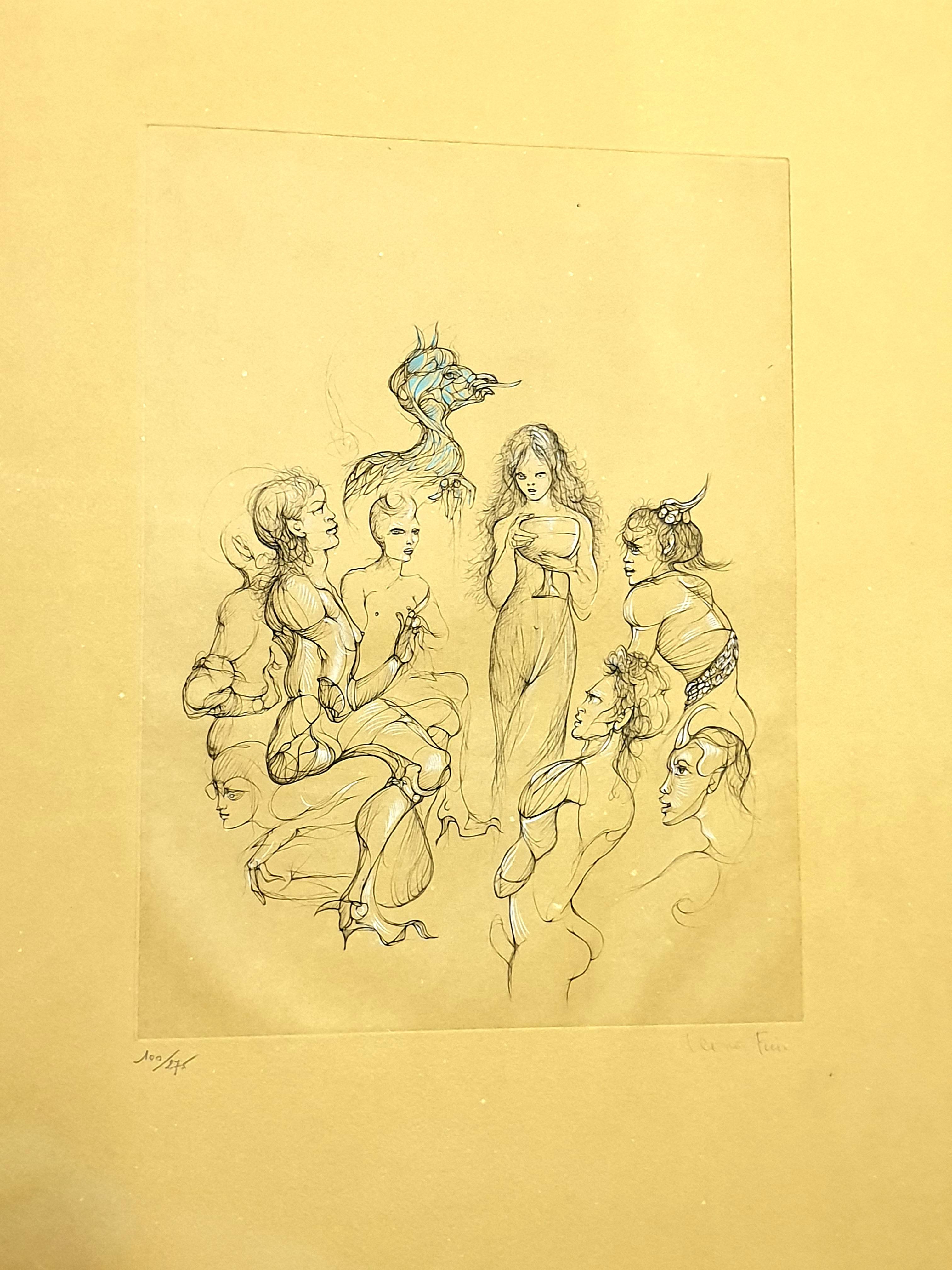Items Similar to Female Nude Lying with Scarf - 1910s
Want more images or videos?
Request additional images or videos from the seller
1 of 9
(after) Gustav KlimtFemale Nude Lying with Scarf - 1910s1919
1919
About the Item
Female Nude Lying with Scarf is a vintage, beautiful, and rare collotype from “Gustav Klimt: Fünfundzwanzig Handzeichnungen”, a limited-edition collection of 25 monochrome and two-tone collotypes after drawings by Gustav Klimt.
Published by Gilhofer and Ranschburg, Vienna, July 1919, just one year after Klimt's death, with a sophisticated technique to perfectly reproduce Klimt's pencil strokes. Edition of 500 numbered prints, with the first group numbered I-X and the second numbered 11-500.
This is a breathtaking monochrome original print, represents a young lady lying with a voluminous scarf, and showing her nakedness. Signed on stone on the lower right margin. In excellent conditions, including an ivory-colored cardboard passepartout slightly worn out that we wanted to keep in its original state (cm 59.3 x 40.1).
Original Title: Liegender, weiblicher Akt, mit Halskrause (rot getönt)
The original pencil sketch is held at the Lederer Collection, in Vienna, together with the other original drawings of the portfolio.
All the works were printed posthumously, one year after Klimt’s death, by the Kunstanstalt Max Jaffé, a Viennese specialist in fine art collotypes.
The complex collotype printing process perfectly rendered Klimt’s remarkably spontaneous drawing style.
This dichromate-based photographic process was invented in 1856, before lithography. The gelatin plates required a very delicate preparation involving light exposure, washing, and drying. Collotype plates could not be re-used: the limited-edition prints from colloid ink were stable and they had no chance of fading like other photographic processes of the time. Later on, lithography replaced this technique, which has now become nearly forgotten.
The importance of this portfolio lies in the aesthetic achievement of capturing the variations of Klimt's style between 1898 and 1917. These drawings of women are suffused by a veil of sexuality, well-accepted by the Viennese society. Fünfundzwanzig Handzeichnungen is erotic material that would circulate privately among Vienna's upper-class men. The emotional fluidity of Klimt’s erotic drawings created and still creates an intense psychological reaction in the viewer.
Fünfundzwanzig Handzeichnungen reveals the female world in Klimt's eyes. He meticulously observes both nubile young girls and craggy old women. His drawings demonstrate his unstoppable creative energy and his expertise in the technique.
This artwork is shipped from Italy. Under existing legislation, any artwork in Italy created over 70 years ago by an artist who has died requires a licence for export regardless of the work’s market price. The shipping may require additional handling days to require the licence according to the final destination of the artwork.
- Creator:(after) Gustav Klimt (1862 - 1918, Austrian)
- Creation Year:1919
- Dimensions:Height: 14.18 in (36 cm)Width: 21.66 in (55 cm)
- Medium:
- Movement & Style:
- Period:
- Framing:Framing Options Available
- Condition:Insurance may be requested by customers as additional service, contact us for more information.
- Gallery Location:Roma, IT
- Reference Number:
About the Seller
4.9
Platinum Seller
These expertly vetted sellers are 1stDibs' most experienced sellers and are rated highest by our customers.
1stDibs seller since 2017
6,749 sales on 1stDibs
Typical response time: 2 hours
- ShippingRetrieving quote...Ships From: Monaco, Monaco
- Return PolicyA return for this item may be initiated within 14 days of delivery.
More From This SellerView All
- Nude - Original Lithograph byPaul Belmondo - Mid-20th CenturyLocated in Roma, ITNude is an Original Lithograph print realized by French artist Paul Belmondo (1898-1982) It is not signed and dated but we can attribute the period to...Category
Mid-20th Century Modern Figurative Prints
MaterialsLithograph
- Erotic Scene - Lithograph by Albert Marquet - 1920sBy Albert MarquetLocated in Roma, ITErotic Scene is a beautiful lithograph on ivory-colored paper, realized in the 1920s by Albert Marquet (Bordeaux, 1875 - Paris,1947). Monogrammed on the plate on the lower margin. ...Category
1920s Modern Figurative Prints
MaterialsLithograph
- Erotic Scene - Lithograph by Albert Marquet - 1920sBy Albert MarquetLocated in Roma, ITErotic Scene is a beautiful lithograph on ivory-colored paper, realized in the 1920s by Albert Marquet (Bordeaux, 1875 - Paris,1947). Monogrammed on the plate on the lower margin. ...Category
1920s Modern Figurative Prints
MaterialsLithograph
- Commemoration Of Leopard - Lithograph by Henri Fantin-Latour - 19th CenturyBy Henri Fantin-LatourLocated in Roma, ITCommemoration Of Leopardi is a wonderful black and white lithograph onpaper, realized in the late 19 century by the French artist Henri Fantin-Latour (Gre...Category
19th Century Modern Figurative Prints
MaterialsLithograph
- Nude - Monotype by Louis-Albert Demangeon - Mid 20th CenturyLocated in Roma, ITNude is a Monotype print realized by Louis-Albert Demangeon in the mid-20th century. Hand-signed In Good condition. The artwork is depicted through soft strokes in a well-balanced...Category
Mid-20th Century Modern Figurative Prints
MaterialsMonotype, Lithograph
- Standing Male Nude - Lithograph - 2007By Egon SchieleLocated in Roma, ITStanding Male Nude is a beautiful colored lithograph from the portfolio " Erotica " after Egon Schiele. It deals with a reproduction of the homonym artwork realized in pencil by Eg...Category
Early 2000s Modern Figurative Prints
MaterialsLithograph
You May Also Like
- Untitled nude woman framed lithograph by artist Aristide MaillolBy Aristide MaillolLocated in Boca Raton, FLFramed lithograph of a female nude pastel by artist Aristide Maillol. Image size: 12 1/2 x 9 1/2 inches. Framed under glass in wooden frame.Category
20th Century Modern Figurative Prints
MaterialsLithograph
- Nude Lying Down framed lithograph of woman by artist Aristide MaillolBy Aristide MaillolLocated in Boca Raton, FLFramed lithograph of a female Nude Lying Down pastel by artist Aristide Maillol. Image size: 9 1/4 x 14 1/2 inches. Framed under glass in wooden frame.Category
20th Century Modern Figurative Prints
MaterialsLithograph
- Untitled framed lithograph by Aristide MaillolBy Aristide MaillolLocated in Boca Raton, FLFramed lithograph of female nude of pastel by Aristide Maillol. Initials in lower-right corner. Framed under glass in wooden frame.Category
20th Century Modern Figurative Prints
MaterialsLithograph
- Marc Chagall - Moses with Tablets of Stone - Original LithographBy Marc ChagallLocated in Collonge Bellerive, Geneve, CHMarc Chagall, Original Lithograph depicting an instant of the Bible. Technique: Original lithograph in colours Year: 1956 Sizes: 35,5 x 26 cm / 14" x 10.2" (sheet) Published by: Éditions de la Revue Verve, Tériade, Paris Printed by: Atelier Mourlot, Paris Documentation / References: Mourlot, F., Chagall Lithograph [II] 1957-1962, A. Sauret, Monte Carlo 1963, nos. 234 and 257 Marc Chagall (born in 1887) Marc Chagall was born in Belarus in 1887 and developed an early interest in art. After studying painting, in 1907 he left Russia for Paris, where he lived in an artist colony on the city’s outskirts. Fusing his own personal, dreamlike imagery with hints of the fauvism and cubism popular in France at the time, Chagall created his most lasting work—including I and the Village (1911)—some of which would be featured in the Salon des Indépendants exhibitions. After returning to Vitebsk for a visit in 1914, the outbreak of WWI trapped Chagall in Russia. He returned to France in 1923 but was forced to flee the country and Nazi persecution during WWII. Finding asylum in the U.S., Chagall became involved in set and costume design before returning to France in 1948. In his later years, he experimented with new art forms and was commissioned to produce numerous large-scale works. Chagall died in St.-Paul-de-Vence in 1985. The Village Marc Chagall was born in a small Hassidic community on the outskirts of Vitebsk, Belarus, on July 7, 1887. His father was a fishmonger, and his mother ran a small sundries shop in the village. As a child, Chagall attended the Jewish elementary school, where he studied Hebrew and the Bible, before later attending the Russian public school. He began to learn the fundamentals of drawing during this time, but perhaps more importantly, he absorbed the world around him, storing away the imagery and themes that would feature largely in most of his later work. At age 19 Chagall enrolled at a private, all-Jewish art school and began his formal education in painting, studying briefly with portrait artist Yehuda Pen. However, he left the school after several months, moving to St. Petersburg in 1907 to study at the Imperial Society for the Protection of Fine Arts. The following year, he enrolled at the Svanseva School, studying with set designer Léon Bakst, whose work had been featured in Sergei Diaghilev's Ballets Russes. This early experience would prove important to Chagall’s later career as well. Despite this formal instruction, and the widespread popularity of realism in Russia at the time, Chagall was already establishing his own personal style, which featured a more dreamlike unreality and the people, places and imagery that were close to his heart. Some examples from this period are his Window Vitebsk (1908) and My Fianceé with Black Gloves (1909), which pictured Bella Rosenfeld, to whom he had recently become engaged. The Beehive Despite his romance with Bella, in 1911 an allowance from Russian parliament member and art patron Maxim Binaver enabled Chagall to move to Paris, France. After settling briefly in the Montparnasse neighborhood, Chagall moved further afield to an artist colony known as La Ruche (“The Beehive”), where he began to work side by side with abstract painters such as Amedeo Modigliani and Fernand Léger as well as the avant-garde poet Guillaume Apollinaire. At their urging, and under the influence of the wildly popular fauvism and cubism, Chagall lightened his palette and pushed his style ever further from reality. I and the Village (1911) and Homage to Apollinaire (1912) are among his early Parisian works, widely considered to be his most successful and representative period. Though his work stood stylistically apart from his cubist contemporaries, from 1912 to 1914 Chagall exhibited several paintings at the annual Salon des Indépendants exhibition, where works by the likes of Juan Gris, Marcel Duchamp and Robert Delaunay were causing a stir in the Paris art world. Chagall’s popularity began to spread beyond La Ruche, and in May 1914 he traveled to Berlin to help organize his first solo exhibition, at Der Sturm Gallery. Chagall remained in the city until the highly acclaimed show opened that June. He then returned to Vitebsk, unaware of the fateful events to come. War, Peace and Revolution In August 1914 the outbreak of World War I precluded Chagall’s plans to return to Paris. The conflict did little to stem the flow of his creative output, however, instead merely giving him direct access to the childhood scenes so essential to his work, as seen in paintings such as Jew in Green (1914) and Over Vitebsk (1914). His paintings from this period also occasionally featured images of the war’s impact on the region, as with Wounded Soldier (1914) and Marching (1915). But despite the hardships of life during wartime, this would also prove to be a joyful period for Chagall. In July 1915 he married Bella, and she gave birth to a daughter, Ida, the following year. Their appearance in works such as Birthday (1915), Bella and Ida by the Window (1917) and several of his “Lovers” paintings give a glimpse of the island of domestic bliss that was Chagall’s amidst the chaos. To avoid military service and stay with his new family, Chagall took a position as a clerk in the Ministry of War Economy in St. Petersburg. While there he began work on his autobiography and also immersed himself in the local art scene, befriending novelist Boris Pasternak, among others. He also exhibited his work in the city and soon gained considerable recognition. That notoriety would prove important in the aftermath of the 1917 Russian Revolution when he was appointed as the Commissar of Fine Arts in Vitebsk. In his new post, Chagall undertook various projects in the region, including the 1919 founding of the Academy of the Arts. Despite these endeavors, differences among his colleagues eventually disillusioned Chagall. In 1920 he relinquished his position and moved his family to Moscow, the post-revolution capital of Russia. In Moscow, Chagall was soon commissioned to create sets and costumes for various productions at the Moscow State Yiddish...Category
1950s Modern Figurative Prints
MaterialsLithograph
- Marc Chagall - Moses - Original LithographBy Marc ChagallLocated in Collonge Bellerive, Geneve, CHMarc Chagall, Original Lithograph depicting an instant of the Bible. Technique: Original lithograph in colours Year: 1956 Sizes: 35,5 x 26 cm / 14" x 10.2" (sheet) Published by: Éditions de la Revue Verve, Tériade, Paris Printed by: Atelier Mourlot, Paris Documentation / References: Mourlot, F., Chagall Lithograph [II] 1957-1962, A. Sauret, Monte Carlo 1963, nos. 234 and 257 Marc Chagall (born in 1887) Marc Chagall was born in Belarus in 1887 and developed an early interest in art. After studying painting, in 1907 he left Russia for Paris, where he lived in an artist colony on the city’s outskirts. Fusing his own personal, dreamlike imagery with hints of the fauvism and cubism popular in France at the time, Chagall created his most lasting work—including I and the Village (1911)—some of which would be featured in the Salon des Indépendants exhibitions. After returning to Vitebsk for a visit in 1914, the outbreak of WWI trapped Chagall in Russia. He returned to France in 1923 but was forced to flee the country and Nazi persecution during WWII. Finding asylum in the U.S., Chagall became involved in set and costume design before returning to France in 1948. In his later years, he experimented with new art forms and was commissioned to produce numerous large-scale works. Chagall died in St.-Paul-de-Vence in 1985. The Village Marc Chagall was born in a small Hassidic community on the outskirts of Vitebsk, Belarus, on July 7, 1887. His father was a fishmonger, and his mother ran a small sundries shop in the village. As a child, Chagall attended the Jewish elementary school, where he studied Hebrew and the Bible, before later attending the Russian public school. He began to learn the fundamentals of drawing during this time, but perhaps more importantly, he absorbed the world around him, storing away the imagery and themes that would feature largely in most of his later work. At age 19 Chagall enrolled at a private, all-Jewish art school and began his formal education in painting, studying briefly with portrait artist Yehuda Pen. However, he left the school after several months, moving to St. Petersburg in 1907 to study at the Imperial Society for the Protection of Fine Arts. The following year, he enrolled at the Svanseva School, studying with set designer Léon Bakst, whose work had been featured in Sergei Diaghilev's Ballets Russes. This early experience would prove important to Chagall’s later career as well. Despite this formal instruction, and the widespread popularity of realism in Russia at the time, Chagall was already establishing his own personal style, which featured a more dreamlike unreality and the people, places and imagery that were close to his heart. Some examples from this period are his Window Vitebsk (1908) and My Fianceé with Black Gloves (1909), which pictured Bella Rosenfeld, to whom he had recently become engaged. The Beehive Despite his romance with Bella, in 1911 an allowance from Russian parliament member and art patron Maxim Binaver enabled Chagall to move to Paris, France. After settling briefly in the Montparnasse neighborhood, Chagall moved further afield to an artist colony known as La Ruche (“The Beehive”), where he began to work side by side with abstract painters such as Amedeo Modigliani and Fernand Léger as well as the avant-garde poet Guillaume Apollinaire. At their urging, and under the influence of the wildly popular fauvism and cubism, Chagall lightened his palette and pushed his style ever further from reality. I and the Village (1911) and Homage to Apollinaire (1912) are among his early Parisian works, widely considered to be his most successful and representative period. Though his work stood stylistically apart from his cubist contemporaries, from 1912 to 1914 Chagall exhibited several paintings at the annual Salon des Indépendants exhibition, where works by the likes of Juan Gris, Marcel Duchamp and Robert Delaunay were causing a stir in the Paris art world. Chagall’s popularity began to spread beyond La Ruche, and in May 1914 he traveled to Berlin to help organize his first solo exhibition, at Der Sturm Gallery. Chagall remained in the city until the highly acclaimed show opened that June. He then returned to Vitebsk, unaware of the fateful events to come. War, Peace and Revolution In August 1914 the outbreak of World War I precluded Chagall’s plans to return to Paris. The conflict did little to stem the flow of his creative output, however, instead merely giving him direct access to the childhood scenes so essential to his work, as seen in paintings such as Jew in Green (1914) and Over Vitebsk (1914). His paintings from this period also occasionally featured images of the war’s impact on the region, as with Wounded Soldier (1914) and Marching (1915). But despite the hardships of life during wartime, this would also prove to be a joyful period for Chagall. In July 1915 he married Bella, and she gave birth to a daughter, Ida, the following year. Their appearance in works such as Birthday (1915), Bella and Ida by the Window (1917) and several of his “Lovers” paintings give a glimpse of the island of domestic bliss that was Chagall’s amidst the chaos. To avoid military service and stay with his new family, Chagall took a position as a clerk in the Ministry of War Economy in St. Petersburg. While there he began work on his autobiography and also immersed himself in the local art scene, befriending novelist Boris Pasternak, among others. He also exhibited his work in the city and soon gained considerable recognition. That notoriety would prove important in the aftermath of the 1917 Russian Revolution when he was appointed as the Commissar of Fine Arts in Vitebsk. In his new post, Chagall undertook various projects in the region, including the 1919 founding of the Academy of the Arts. Despite these endeavors, differences among his colleagues eventually disillusioned Chagall. In 1920 he relinquished his position and moved his family to Moscow, the post-revolution capital of Russia. In Moscow, Chagall was soon commissioned to create sets and costumes for various productions at the Moscow State Yiddish...Category
1950s Modern Figurative Prints
MaterialsLithograph
- Leonor Fini - Toads - Original Handsigned LithographBy Leonor FiniLocated in Collonge Bellerive, Geneve, CHLeonor Fini - Toads - Original Handsigned Lithograph Circa 1982 On colored paper Handsigned and Numbered Edition: 275 Dimensions: 69 x 52.5 cmCategory
1980s Modern Nude Prints
MaterialsLithograph
Recently Viewed
View AllMore Ways To Browse
Printed Vintage Scarf
Vintage Scarf Print
Klimt Signed
Nude Sketch Modern
Modern Nude Sketches
Women Scarfes
Womens Scarf
Women Scarf
Antique Washing
Nudes Female Print Lithograph
Viennese 1910
Lady Dior Beige
No Time To Die Limited Edition
Naked Plate
Nude Sketch Women
Vienna 1910s
Antique Erotic Prints
Sophisticated Lady
